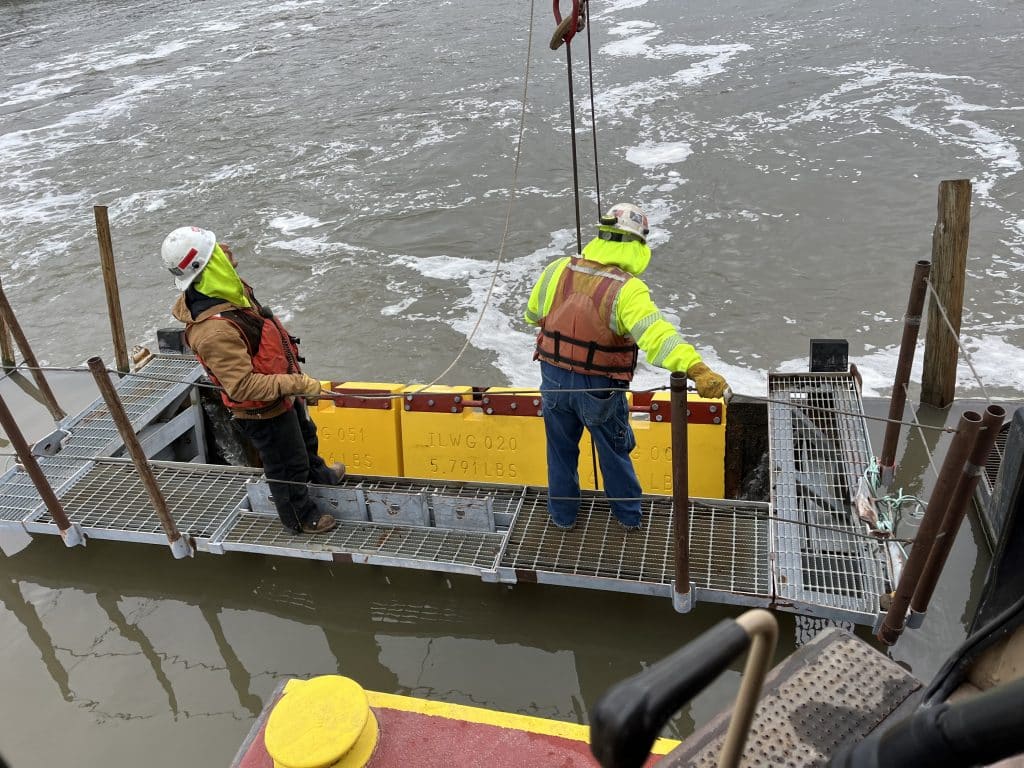

FRP Opens the Flood Gates on an Expanding Market
A decade ago, the U.S. Army Corps of Engineers (USACE) installed demonstration wicket gates made from E-glass and vinyl ester resin in a sandwich panel construction on the Illinois River, replacing white oak timber gates. Since then, the USACE has ramped up its investment in composites for water navigation and flood management structures to meet new 100-year design life standards.
In July 2024, the Army Corps issued an Engineering and Construction Bulletin to its 37 Civil Works Districts, which oversee water resource projects, directing them to consider FRP in the design and construction of hydraulic structures in future budgets. And there are a lot of them. Based on previous 50-year design life requirements, the USACE is on the cusp of replacing 260 hydraulic structures per year that were built between 1920 and 1975.
“The Engineering and Construction Bulletin is a significant signal to the districts that all hydraulic steel structures have to be assessed for FRP applications when they witness replacement or life-extending maintenance,” says Robert Germann, PE, technical manager for the South Atlantic Division of the USACE. “That goes beyond our 200-plus locks and dams for navigation and includes our flood risk management dams as well, which basically doubles the number of components.”
The Army Corps completed a handful of FRP projects in 2023, including more than 100 wicket gates for the Illinois Waterway, a system of rivers and canals that connects Lake Michigan to the Mississippi River. Last year, it awarded seven contracts totaling nearly $20 million at sites across the U.S., ranging from bulkheads in Wilmington, N.C., to lock gate contact blocks in Seattle.
Canadian-based CMSI landed two of the seven Army Corps’ contracts through its U.S. subsidiary. The first, awarded in May 2024, is for eight lift gates on the W.P. Franklin Lock and Dam and 10 bulkheads on the Port Mayaca Lock and Dam, both in the Jacksonville District in Florida. The second, awarded in November 2024, is for four tainter valves on the Mississippi River in Illinois City, Ill. All the structures will be made from E-glass and vinyl ester resin via vacuum-assisted resin transfer molding.
“We pursued this work because we love really big, complex applications,” says Shawn Beamish, CEO and founder of CMSI. “Fiber-reinforced polymer is a fantastic material. As the Army Corps has pointed out, it has 10-to-1 life cost advantages on a 100-year life design. That gives it a competitive advantage, particularly in waterways infrastructure.”
CMSI has begun manufacturing the 39 x 19-foot lift gates and 31 x 3½-foot bulkheads for the Jacksonville District at its South Carolina plant to meet an October 2025 delivery date. Each of the structures must fall within 10% of the maximum weight requirement set forth by the Army Corps to accommodate the load bearing capacity of the existing lifting apparatus on the lock and dams.
“There are a lot of places where we know we could improve the design and make things stiffer and lighter,” says Beamish. “But we are working within the constraints of the contract – and for good reason. The structures have to work in tandem with the lock and dams’ steel mechanical components, and they also require some level of dead weight to hold them in position submerged in water.”
As CMSI builds its relationship with the Army Corps, Beamish is confident they will collaborate to continue improving hydraulic structures. “The Corps is fantastic,” he says. “They have great internal technical expertise that challenges our assumptions and designs. They truly take the approach that we are a team.”
Beamish is optimistic about the waterway navigation market not just for his company, but for the entire composites industry. “There is great opportunity right now to apply yourself in this space,” he says.
CMSI first learned about the USACE’s needs in the Jacksonville District at a 2023 outreach event for ACMA members at the W.P. Franklin Lock and Dam. “It’s critical that you get your eyes on these projects, and you understand the complexities and variables at play in each of these unique structures,” says Beamish.
In addition to outreach events, the Army Corps also holds industry days a month or two before it advertises a solicitation for a new project.
“The goal of these meetings is to get input from composites companies in advance,” says Eric Johnson, PE, technical manager for the hydraulic composite structure program at USACE’s Inland Navigation Design Center. “We show companies what we are thinking conceptually, and then fabricators can provide insight. Maybe they know something simply can’t be built or will be too expensive if you build it a certain way. It’s good feedback for us.”
Similarly, ACMA is helping educate the Army Corps to foster stronger relationships with the composites industry. The association facilitated three training programs in 2024 attended by 66 USACE design engineers and operations and maintenance employees. Curriculum for the program, which includes classroom instruction and hands-on training, covers FRP materials, molding techniques, inspection methods, composite repair and more. ACMA will offer three more classes this year.
“We are trying to grow the market,” says Johnson. “The demand side of the equation is rising, and so far, fabricators on the supply side have been able to meet our needs. But we need more industry partners to keep it up.”

SUBSCRIBE TO CM MAGAZINE
Composites Manufacturing Magazine is the official publication of the American Composites Manufacturers Association. Subscribe to get a free annual subscription to Composites Manufacturing Magazine and receive composites industry insights you can’t get anywhere else.



